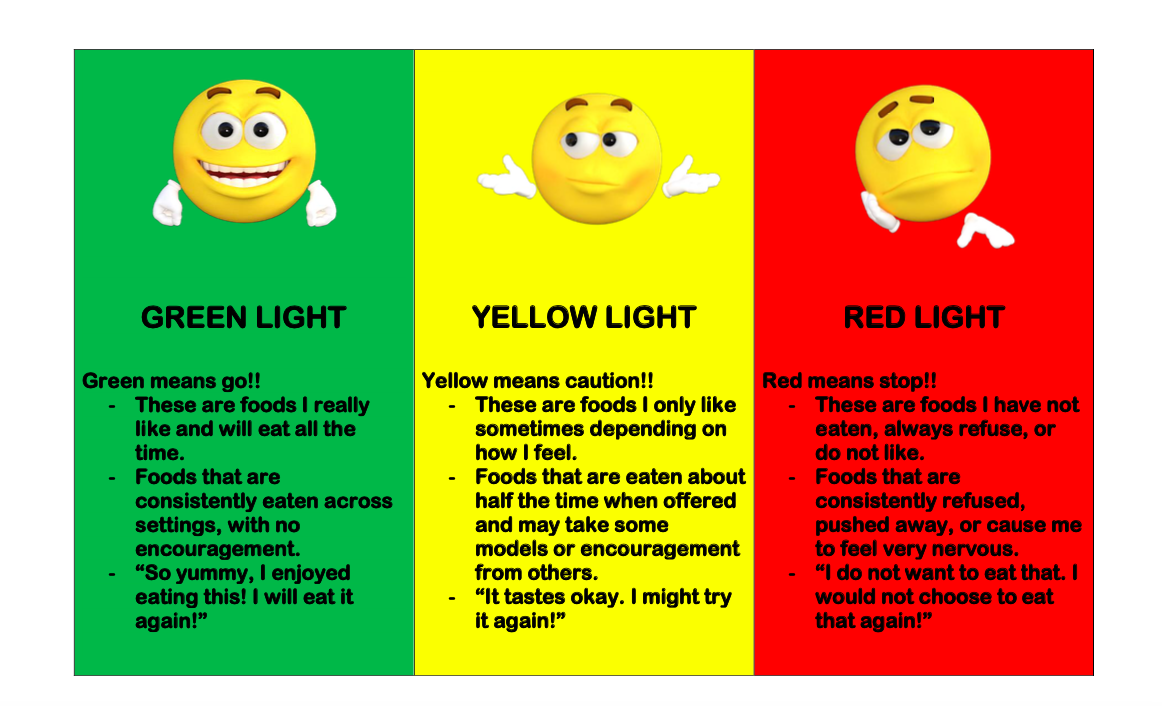Green Light, Yellow Light, Red Light

Description
Visual resource for feeding therapy to categorize current foods in a child's diet and achieve full inventory list of accepted or non-preferred foods.
Strategies and techniques
Just like a stoplight, food preferences are always changing! You can acknowledge that as the colors on the lights change, we can also change what foods we like to eat!
Visual graphic categorizing green, yellow, and red foods according to the child's preference. Attached is a log where therapist, child, and parent/caregiver can list out all foods in their current diet and place them in the correct category. This log can also serve as a way to shift some "target" foods for the family into the green or yellow categories. First page can also be used when introducing a new food to the child's diet. The child is able to assume a sense of independence by placing food in appropriate category, with the goal of wanting to get as many foods in the green light column as possible!
Emoticon images from Pixabay.
Happy Face: https://pixabay.com/illustrations/emoticon-emoji-smile-happy-1610573/
Not Sure Face: https://pixabay.com/illustrations/emoticon-emoji-yellow-face-smile-1634586/
Visual graphic categorizing green, yellow, and red foods according to the child's preference. Attached is a log where therapist, child, and parent/caregiver can list out all foods in their current diet and place them in the correct category. This log can also serve as a way to shift some "target" foods for the family into the green or yellow categories. First page can also be used when introducing a new food to the child's diet. The child is able to assume a sense of independence by placing food in appropriate category, with the goal of wanting to get as many foods in the green light column as possible!
Emoticon images from Pixabay.
Happy Face: https://pixabay.com/illustrations/emoticon-emoji-smile-happy-1610573/
Not Sure Face: https://pixabay.com/illustrations/emoticon-emoji-yellow-face-smile-1634586/
License
Additional information
Resource details

Description
Visual resource for feeding therapy to categorize current foods in a child's diet and achieve full inventory list of accepted or non-preferred foods.
Strategies and techniques
Just like a stoplight, food preferences are always changing! You can acknowledge that as the colors on the lights change, we can also change what foods we like to eat!
Visual graphic categorizing green, yellow, and red foods according to the child's preference. Attached is a log where therapist, child, and parent/caregiver can list out all foods in their current diet and place them in the correct category. This log can also serve as a way to shift some "target" foods for the family into the green or yellow categories. First page can also be used when introducing a new food to the child's diet. The child is able to assume a sense of independence by placing food in appropriate category, with the goal of wanting to get as many foods in the green light column as possible!
Emoticon images from Pixabay.
Happy Face: https://pixabay.com/illustrations/emoticon-emoji-smile-happy-1610573/
Not Sure Face: https://pixabay.com/illustrations/emoticon-emoji-yellow-face-smile-1634586/
Visual graphic categorizing green, yellow, and red foods according to the child's preference. Attached is a log where therapist, child, and parent/caregiver can list out all foods in their current diet and place them in the correct category. This log can also serve as a way to shift some "target" foods for the family into the green or yellow categories. First page can also be used when introducing a new food to the child's diet. The child is able to assume a sense of independence by placing food in appropriate category, with the goal of wanting to get as many foods in the green light column as possible!
Emoticon images from Pixabay.
Happy Face: https://pixabay.com/illustrations/emoticon-emoji-smile-happy-1610573/
Not Sure Face: https://pixabay.com/illustrations/emoticon-emoji-yellow-face-smile-1634586/
License
Focus areas
- FT -> Behavior -> Meal-time Behavior / Family and Social Interaction
- FT -> Behavior -> Selectivity by Texture
- FT -> Behavior -> Tolerance
- FT -> Nutrition -> Expanding Variety
- FT -> Sensory -> Visual
- FT -> Swallowing -> Therapeutic Strategies
1 more focus area. Click arrow to view all.
Evidence based practice citations
-
Pediatric Sensory-Based Feeding Difficulties - Conditions and Treatments
Author(s): Children's National Hospital -
A Little PEP Goes a Long Way In the Treatment of Pediatric Feeding Disorders
Author(s): Teresa Boggs and Neina Ferguson
Grade levels
Grades K - 3
Themes
Weekly Themes
None
Daily Themes
None
Blends
None
Phonemes
None
Resource slides
Create a free Ambiki account to preview the slides of this PDF resource.
